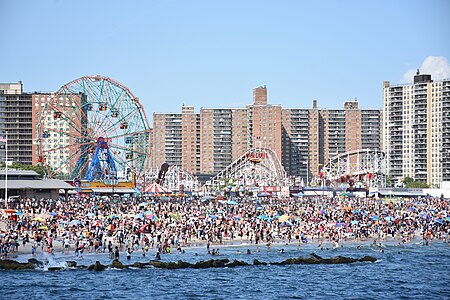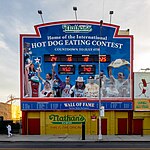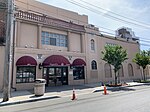Coney Island

Coney Island is a peninsular neighborhood and entertainment area in the southwestern section of the New York City borough of Brooklyn. The neighborhood is bounded by Brighton Beach and Manhattan Beach to its east, Lower New York Bay to the south and west, and Gravesend to the north and includes the subsection of Sea Gate on its west. More broadly, Coney Island or sometimes for clarity the Coney Island peninsula consists of Coney Island proper, Brighton Beach and Manhattan Beach. This was formerly the westernmost of the Outer Barrier islands on the southern shore of Long Island, but in the early 20th century it became a peninsula, connected to the rest of Long Island by land fill. The origin of Coney Island's name is disputed, but the area was originally part of the colonial town of Gravesend. By the mid-19th century it had become a seaside resort, and by the late 19th century, amusement parks had also been built at the location. The attractions reached a historical peak during the first half of the 20th century. However, they declined in popularity after World War II and, following years of neglect, several structures were torn down. Various redevelopment projects were proposed for Coney Island in the 1970s through the 2000s, though most of these were not carried out. The area was revitalized with the opening of MCU Park in 2001 and several amusement rides starting in the 2010s. Coney Island had around 32,000 residents as of the 2010 United States Census. The neighborhood is ethnically diverse, and the neighborhood's poverty rate of 27% is slightly higher than that of the city as a whole. Coney Island is part of Brooklyn Community District 13, and its primary ZIP Code is 11224. It is patrolled by the 60th Precinct of the New York City Police Department. Fire services are provided by the New York City Fire Department's Engine 245/Ladder 161/Battalion 43 and Engine 318/Ladder 166. Politically, Coney Island is represented by the New York City Council's 47th District. The area is well served by the New York City Subway and local bus routes, and contains several public elementary and middle schools.
Excerpt from the Wikipedia article Coney Island (License: CC BY-SA 3.0, Authors, Images).Coney Island
Surf Avenue, New York Brooklyn
Geographical coordinates (GPS) Address Phone number Website Nearby Places Show on map
Geographical coordinates (GPS)
| Latitude | Longitude |
|---|---|
| N 40.575 ° | E -73.9825 ° |
Address
Luna Park
Surf Avenue 1000
11224 New York, Brooklyn
New York, United States
Open on Google Maps










